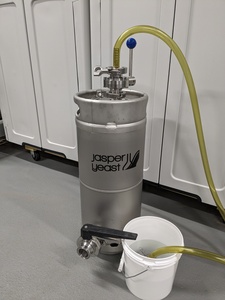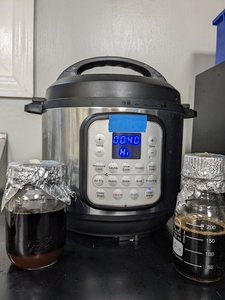Why learning to brew great lagers will make your IPAs (and other beers) even better
First I brewed a bunch of ales for six years. Then I focused on brewing lagers for the next six years. The result? My ales improved in quality. Below is a general discussion on why prioritizing lagers will improve every beer on tap.
We sample a lot of beers at Jasper Yeast (hey, it's part of the job) and we've noticed one surprising correlation. Breweries that make great IPAs often make fantastic lagers as well. Which one came first? I would argue it's the lagers. IPA's still sell themselves, and in many ways that hinders your efforts to improve quality. It can lead a brewery to feel great about a beer, just because it sells quickly. If you've tried hundreds of IPAs, you definitely have a preference for one over the other. For a customer, he or she might simply say, "this one is better." For a brewer, they know it's the water profile, fermentation temperature, malt bill, dry hopping regimen, and cold side conditioning that all contribute small parts that make a great beer. Lager brewers pride themselves on being very particular and attune to the nuance and flavors of lagers. I think great IPA brewers feel the same way about their ales. In many instances they learned good techniques by consistently brewing a great lager. They then used those same techniques to brew a great IPA.
Many industry folks say, "lagers are more challenging to brew, ales are more forgiving." This translates to, "It's easier to brew and sell a passable ale. It's much tougher to sell a passable lager." The benefit of brewing lower abv lagers is It's much easier to pick up on their off flavors. If they're somewhat masked in a hoppy beer, that doesn't mean they go unnoticed, simply that it's harder to pinpoint them.
Our Challenge
Brew a helles. Ask your team, or someone else's team to be brutally honest about the beer. Enlist several BJCP or BA certified judges to professionally judge your beer. Taste your beers every week to see how the flavor changes over time. Take notes and include as much information as possible. Surprisingly, some brewers fall into the habit of drinking the beers they brew, but not analyzing and critiquing their beers. Then get to work addressing their notes.
Is there some astringency? Maybe it's the excessively high sparge temperature. Is there more esters than expected? What was the pitch rate and initial fermentation temperature? Is it thin and dry? What was the mash temperature? Did you select the best yeast strain for this batch? Is there an autolyzed character in the beer? Maybe you waited too long to harvest the yeast. A green apple character? Consider you didn't let the yeast age long enough and rushed the lagering process. Has the color changed, or does it taste oxidized after several weeks in the bright? It's possible there's oxygen ingress during the transfer.
You can pickup on these flavors in an 8% Double IPA as well, but it is more difficult. Take a close look at your lager program. If there's room to improve, work on it, ask questions, and get perspective. Once you've made a great beer, see if you can consistently make it again. Use these lessons and apply it to your IPAs. We know countless breweries that have improved every beer on tap by focusing on improving their lagers first. We'll go into more details in other articles about specific off flavors, and techniques that make a fantastic lager even better.
Many industry folks say, "lagers are more challenging to brew, ales are more forgiving." This translates to, "It's easier to brew and sell a passable ale. It's much tougher to sell a passable lager." The benefit of brewing lower abv lagers is It's much easier to pick up on their off flavors. If they're somewhat masked in a hoppy beer, that doesn't mean they go unnoticed, simply that it's harder to pinpoint them.
Our Challenge
Brew a helles. Ask your team, or someone else's team to be brutally honest about the beer. Enlist several BJCP or BA certified judges to professionally judge your beer. Taste your beers every week to see how the flavor changes over time. Take notes and include as much information as possible. Surprisingly, some brewers fall into the habit of drinking the beers they brew, but not analyzing and critiquing their beers. Then get to work addressing their notes.
Is there some astringency? Maybe it's the excessively high sparge temperature. Is there more esters than expected? What was the pitch rate and initial fermentation temperature? Is it thin and dry? What was the mash temperature? Did you select the best yeast strain for this batch? Is there an autolyzed character in the beer? Maybe you waited too long to harvest the yeast. A green apple character? Consider you didn't let the yeast age long enough and rushed the lagering process. Has the color changed, or does it taste oxidized after several weeks in the bright? It's possible there's oxygen ingress during the transfer.
You can pickup on these flavors in an 8% Double IPA as well, but it is more difficult. Take a close look at your lager program. If there's room to improve, work on it, ask questions, and get perspective. Once you've made a great beer, see if you can consistently make it again. Use these lessons and apply it to your IPAs. We know countless breweries that have improved every beer on tap by focusing on improving their lagers first. We'll go into more details in other articles about specific off flavors, and techniques that make a fantastic lager even better.

Stay in the know
Sign up for our newsletter now and hop into the world of brewing excellence.
Related Posts

How to maintain high viability in stored yeast
2023-07-05 22:33:56 UTC
By: Travis Tedrow
Congrats! You have successfully harvested yeast into your brink. Now we will outline the best practices for feeding and storing your yeast to ensure the highest possible viability.

How to DIY your own Yeast Feeders
2023-08-08 04:17:11 UTC
By: Jasper Akerboom
We ship a small bottle of autoclaved media to feed yeast pitch for every order. Below we'll detail how you can make your own yeast feeders with wort from your kettle.
